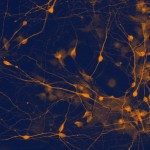Lien vers Pubmed [PMID] – 22330198
Neural Syst Circuits 2011;1(1):6
The olfactory bulb (OB) receives and integrates newborn interneurons throughout life. This process is important for the proper functioning of the OB circuit and consequently, for the sense of smell. Although we know how these new interneurons are produced, the way in which they integrate into the pre-existing ongoing circuits remains poorly documented. Bearing in mind that glutamatergic inputs onto local OB interneurons are crucial for adjusting the level of bulbar inhibition, it is important to characterize when and how these inputs from excitatory synapses develop on newborn OB interneurons. We studied early synaptic events that lead to the formation and maturation of the first glutamatergic synapses on adult-born granule cells (GCs), the most abundant subtype of OB interneuron. Patch-clamp recordings and electron microscopy (EM) analysis were performed on adult-born interneurons shortly after their arrival in the adult OB circuits. We found that both the ratio of N-methyl-D-aspartate receptor (NMDAR) to α-amino-3-hydroxy-5-methyl-4-isoxazolepropionic acid receptor (AMPAR), and the number of functional release sites at proximal inputs reached a maximum during the critical period for the sensory-dependent survival of newborn cells, well before the completion of dendritic arborization. EM analysis showed an accompanying change in postsynaptic density shape during the same period of time. Interestingly, the latter morphological changes disappeared in more mature newly-formed neurons, when the NMDAR to AMPAR ratio had decreased and functional presynaptic terminals expressed only single release sites. Together, these findings show that the first glutamatergic inputs to adult-generated OB interneurons undergo a unique sequence of maturation stages.

